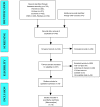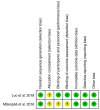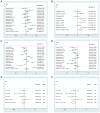Application of robotic surgery and traditional laparoscopic surgery in lymph node dissection for gynecological cancer: A meta‑analysis
- PMID: 37033101
- PMCID: PMC10079865
- DOI: 10.3892/ol.2023.13761
Application of robotic surgery and traditional laparoscopic surgery in lymph node dissection for gynecological cancer: A meta‑analysis
Abstract
Since the advantages of robotic surgery and laparoscopic surgery in the number of lymph node resections are not well understood, this meta-analysis used evidence-based medicine to assess the difference in the number of lymph nodes retrieved in gynecological cancer between the two surgical methods to guide clinical treatment. In the present meta-analysis, the Pubmed, Embase, Cochrane, China National Knowledge Infrastructure and Wanfang libraries were searched for articles that were published from the time of the database's inception to January 2021, including cohort studies and randomized controlled trials, where the observation group underwent robotic surgery to treat gynecological cancers and the control group underwent laparoscopic surgery to treat gynecological cancers, including cervical and ovarian cancers and endometrial cancers. Duplicate publications, studies with no full text, incomplete information or where the authors were unable to perform data extraction, animal experiments, reviews and systematic reviews were excluded. STATA 15.1 was used to analyze the data. Robotic surgery resulted in a significant increase in the number of lymph nodes retrieved from the pelvis [standard mean difference (SMD)=0.24; 95% CI, 0.04-0.45; P=0.007] and para-aortic (SMD=0.41; 95% CI, 0.13-0.69; P=0.004) regions compared with the number retrieved by laparoscopic surgery. Furthermore, there was no significant difference in operating time between robotic and laparoscopic surgery, despite the use of different instruments (SMD=0.12; 95% CI, -0.35-0.58; P=0.616). The amount of blood lost during robotic surgery was significantly less compared with that lost during laparoscopic surgery [SMD=-0.40; 95% CI, -0.58-(-0.22); P<0.001]. The present study evaluated cancer recurrence and death in further detail, and no statistically significant difference was demonstrated between robotic surgery and laparoscopic surgery in terms of recurrence rate [odds ratio (OR)=0.59; 95% CI, 0.21-1.65; P=0.318] and mortality rate (OR=0.31; 95% CI, 0.08-1.30; P=0.109). The present study demonstrated that robotic surgery was able to retrieve more pelvic and para-aortic lymph nodes than traditional laparoscopic surgery, which was consistent with previous reports. With regards to blood loss, The difference in operation time between the two surgical methods was not statistically significant, whereas the estimated blood loss of robotic surgery was significantly lower than that of traditional laparoscopic surgery. There was no statistically significant difference in the recurrence rate and mortality rate of the two surgical modality.
Keywords: gynecological cancer; laparoscopic surgery; lymph node dissection; robotic surgery.
Copyright: © Lu et al.
Conflict of interest statement
The authors declare that they have no competing interests.
Figures





Similar articles
-
Robotic-assisted minimally invasive surgery for gynecologic and urologic oncology: an evidence-based analysis.Ont Health Technol Assess Ser. 2010;10(27):1-118. Epub 2010 Dec 1. Ont Health Technol Assess Ser. 2010. PMID: 23074405 Free PMC article.
-
[Comparison of robotic surgery with laparoscopy for surgical staging of endometrial cancer: a meta-analysis].Zhonghua Fu Chan Ke Za Zhi. 2017 Mar 25;52(3):175-183. doi: 10.3760/cma.j.issn.0529-567X.2017.03.007. Zhonghua Fu Chan Ke Za Zhi. 2017. PMID: 28355689 Review. Chinese.
-
Learning curve and surgical outcome for robotic-assisted hysterectomy with lymphadenectomy: case-matched controlled comparison with laparoscopy and laparotomy for treatment of endometrial cancer.J Minim Invasive Gynecol. 2010 Nov-Dec;17(6):739-48. doi: 10.1016/j.jmig.2010.07.008. J Minim Invasive Gynecol. 2010. PMID: 20955983
-
[Application of robot-assisted laparoscopic sentinel lymph node tracing in treating endometrial carcinoma].Zhonghua Fu Chan Ke Za Zhi. 2022 Nov 25;57(11):830-835. doi: 10.3760/cma.j.cn112141-20221009-00621. Zhonghua Fu Chan Ke Za Zhi. 2022. PMID: 36456479 Chinese.
-
Extended-field radiotherapy for locally advanced cervical cancer.Cochrane Database Syst Rev. 2018 Oct 26;10(10):CD012301. doi: 10.1002/14651858.CD012301.pub2. Cochrane Database Syst Rev. 2018. PMID: 30362204 Free PMC article.
Cited by
-
Use of the vessel sealer in paraaortic lymphadenectomy in the robotic assisted approach in endometrial cancer.Sci Rep. 2025 Mar 10;15(1):8175. doi: 10.1038/s41598-025-93044-y. Sci Rep. 2025. PMID: 40059118 Free PMC article.
-
Gynecological surgery using the Kangduo robotic system.Ann Med. 2025 Dec;57(1):2534096. doi: 10.1080/07853890.2025.2534096. Epub 2025 Jul 20. Ann Med. 2025. PMID: 40684447 Free PMC article.
-
Efficacy and safety of robotic radical hysterectomy in cervical cancer compared with laparoscopic radical hysterectomy: a meta-analysis.Front Oncol. 2024 May 15;14:1303165. doi: 10.3389/fonc.2024.1303165. eCollection 2024. Front Oncol. 2024. PMID: 38812787 Free PMC article.
-
The emerging roles of long non-coding RNA (lncRNA) H19 in gynecologic cancers.BMC Cancer. 2024 Jan 2;24(1):4. doi: 10.1186/s12885-023-11743-z. BMC Cancer. 2024. PMID: 38166752 Free PMC article. Review.
-
Minimally invasive axillary lymph node dissection versus conventional axillary lymph node dissection: a comparative study on short-term efficacy in breast cancer.Surg Endosc. 2025 Aug;39(8):4935-4945. doi: 10.1007/s00464-025-11863-6. Epub 2025 Jun 25. Surg Endosc. 2025. PMID: 40562955
References
LinkOut - more resources
Full Text Sources
